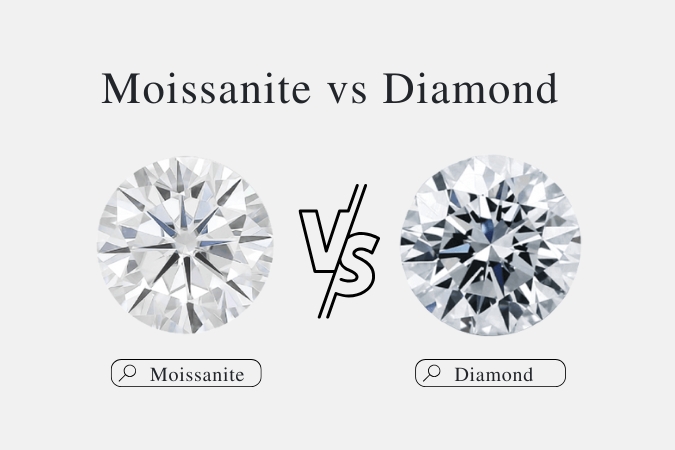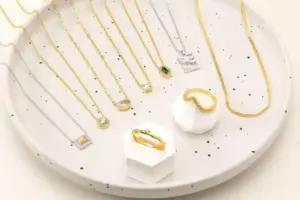Diamonds are celebrated worldwide for their brilliance and prestige—but what about moissanite?
In this guide, we explore the key differences in the moissanite vs diamond debate, covering everything from appearance and price to durability and ethics. While the two gems share striking similarities, understanding what sets them apart helps ensure you’re making an informed, confident choice—whether for an engagement ring or another meaningful purchase.
| Aspect | Moissanite | Diamond |
| Composition | Silicon carbide (compound of silicon and carbon) | Pure carbon (single element) |
| Durability | Mohs hardness 9.25, durable and suitable for daily wear | Mohs hardness 10, highest natural hardness |
| Brilliance | Slightly higher brilliance, refractive index of 2.64 to 2.69 | High refractive index from 2.417 to 2.419 |
| Color | Colorless or near colorless, also in hues of teal, grey, green, yellow, and black | Naturally colorless or colored (yellow, blue, etc.) |
| Price | Much more affordable alternative due to lab production and higher supply | More expensive, especially natural diamonds |
| Sourcing | Almost exclusively lab-grown | Natural (mined) or lab-grown (synthetic) |
What is Moissanite?
Moissanite, which is also known by its trade name “carborundum,” is a naturally occurring compound of silicon carbide and its various crystalline polymorphs. It is very rare and can’t be found in quantities large enough to be made into proper gemstones.
As a result, lab-grown moissanite is typically utilized in jewelry. It comes in a variety of colors. Blue, emerald green, crimson, dark gray, champagne, bright yellow, purple and even black are the various colors offered on the market.
Moissanite is a diamond simulant. In other words, moissanite duplicates diamonds’ aesthetic qualities or appearance. Moissanite is a far less expensive option than diamonds. This is the outcome of supply and demand in the fashion business, not a direct reflection of its quality.
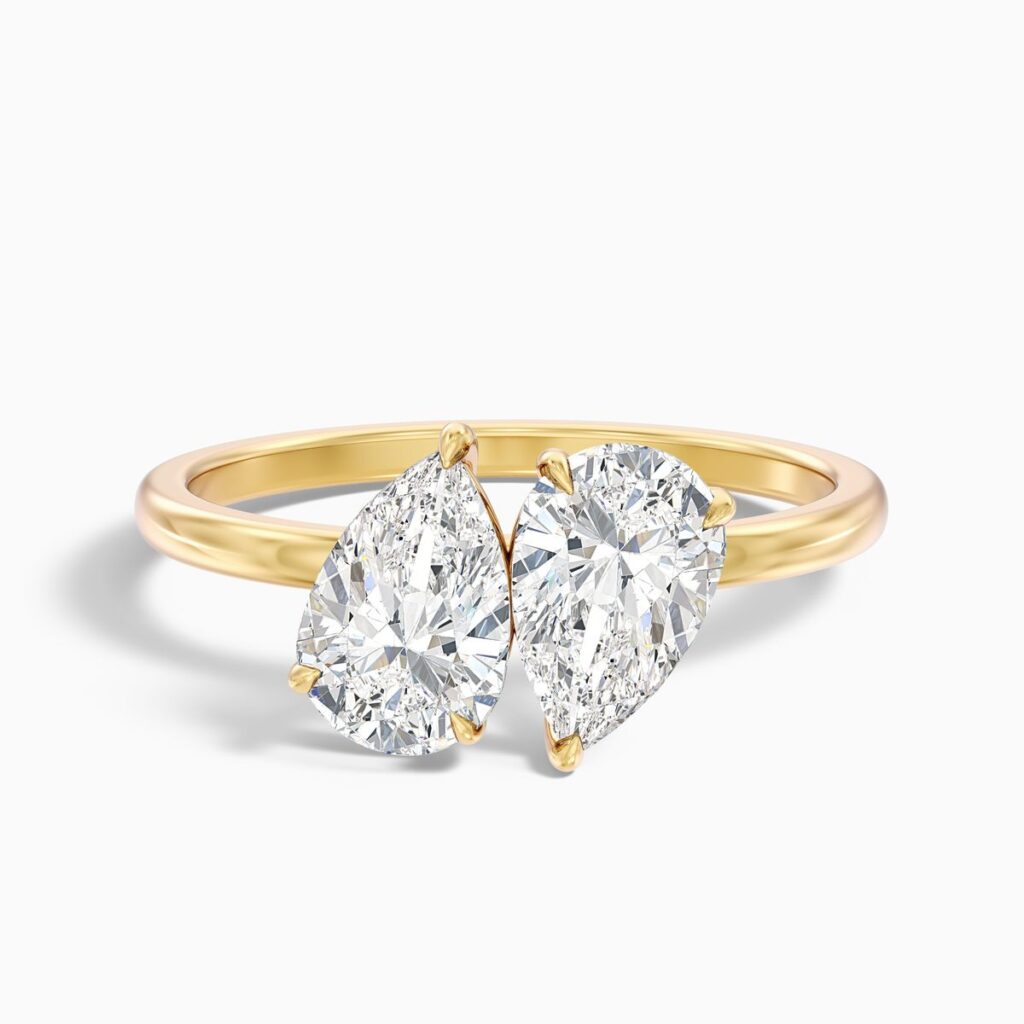
Where Does Moissanite Come From?
The genesis of moissanites is space. Dr. Henri Moissan, a French scientist, found the first moissanite samples in a meteorite crater in Arizona. Because moissanites and diamonds are so similar, the discoverer initially believed he had found diamonds. However, it was eventually discovered that these new crystals were made of silicon carbide, not pure carbon, as in diamonds.
Though we surely adore the thought of donning jewelry from outer space, the reality is that since natural moissanites are so uncommon, all the moissanite jewelry you own is actually produced from lab-grown moissanites.
What Is a Diamond?
Diamonds are rare, naturally occurring minerals composed almost entirely of carbon. They’re the hardest known natural substance (10 on the Mohs scale) and are prized for their brilliance, clarity, and symbolic value—especially in engagement rings. Though typically colorless, diamonds occur in every color due to trace elements like nitrogen (yellow) or boron (blue).
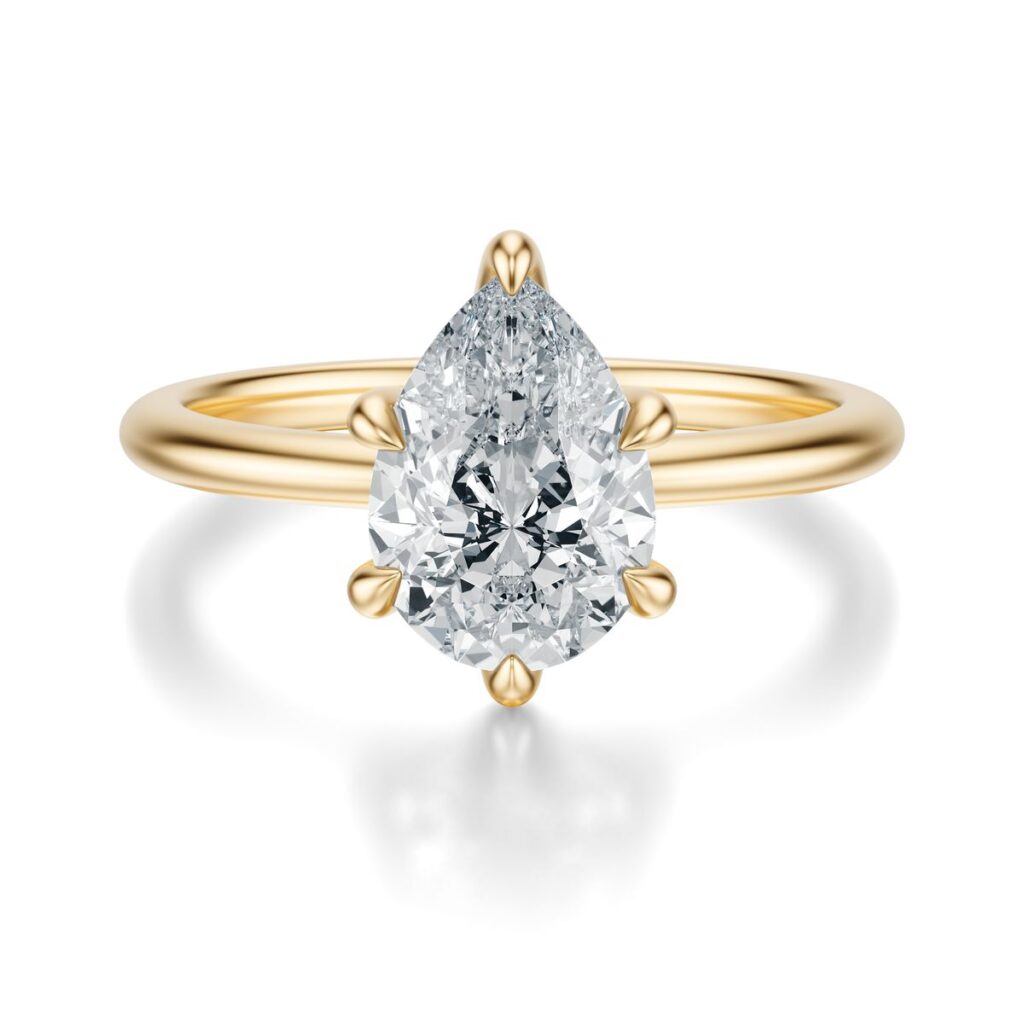
Key Characteristics of Diamonds:
- Refractive Index: With a refractive index of 2.42, diamonds exhibit exceptional brilliance and light reflection.in the gemstone. However, in the case of colored diamonds, the presence of elements other than carbon and trace elements is responsible for coloration. For example, nitrogen is present in yellow diamonds, while boron is present in blue diamonds.
- High Strength: Diamonds resist deformation and fractures under extreme stress, making them incredibly strong in addition to being hard.
- High Hardness: With a Mohs rating of 10, diamonds can only be scratched by other diamonds—perfect for lasting wear.
- Chemical Resistance: Diamonds are inert to most acids and bases, offering excellent resistance to chemical corrosion.
- Thermal Conductivity: Diamonds conduct heat better than any material, outperforming even silver by five times at room temperature.
Where Are Diamonds From?
There are two types of diamond sources: natural diamonds and artificial or lab-made diamonds.
Natural Diamonds
Natural diamonds are diamonds that exist naturally. That is, they do not owe their existence to the direct or indirect actions of man. Natural diamonds are formed when carbon atoms crystallize over a very long period (about 1 to 3.5 billion years) at depths of about 100 miles beneath the earth’s mantle and under extreme heat and pressure conditions.
Once a diamond is formed in these subterranean conditions, it is transported to the earth’s surface by molten rock, where it is mined, purified, and used for jewelry making or other industrial uses.
Artificial Diamonds/Lab-grown Diamonds
Artificial diamonds/lab-grown diamonds, or synthetic diamonds, are created from a synthetic substance that shares the same chemical makeup and fundamental crystal structure as a diamond. Lab-made diamonds are identical to natural diamonds and share the same properties.
The only difference is that they are grown in a laboratory. While it takes billions of years to create a natural diamond, artificial diamonds are formed in a lab within a matter of days (between 3 – 5 days). This implies that compared to synthetic diamonds, natural diamonds are rarer.
Due to technological advances, synthetic diamonds are becoming more common, which is why natural diamonds are more expensive than their synthetic counterparts.
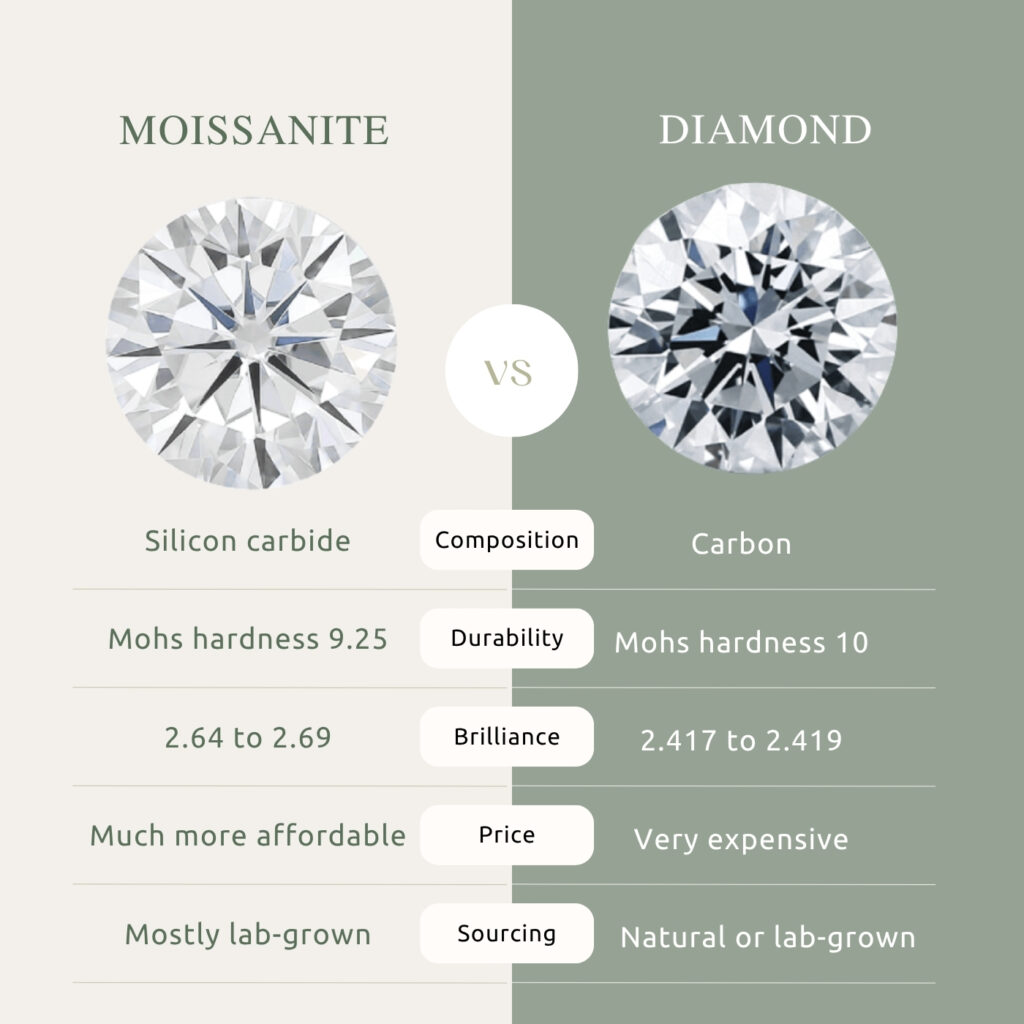
Moissanite vs Diamond: What’s the Difference?
Moissanite is different from diamond and cubic zirconia. Here are detailed comparison of moissanite vs cubic zirconia. Now, let’s explore the major differences between moissanite and diamond:
Composition
- Moissanite: A compound of silicon and carbon (SiC), moissanite has a different atomic arrangement, resulting in distinct optical properties.
- Diamond: Diamonds are 99.5% pure carbon, with the remaining 0.05% consisting of trace elements that sometimes influence color.
Durability
- Moissanite: With a score of 9.25, it’s also highly durable and scratch-resistant—suitable for daily wear, though slightly softer than diamond.
- Diamond: Scores 10 on the Mohs scale, making them the hardest natural substance on earth. This makes them ideal for daily wear, especially in engagement rings.
Brilliance
- Moissanite: More sparkly due to a higher refractive index (2.65–2.69), often showing a rainbow-like flash under lighting. Some find it more “fiery,” others less natural-looking.
- Diamond: Offers sharp, white sparkle with a refractive index of 2.42. Its fire is elegant and subtle.
Color
- Moissanite: Marketed as colorless, but may show a slight yellow, green, or gray tint in certain lighting. Also available in lab-created colors.
- Diamond: Available in both colorless and fancy colored varieties such as pink, blue and yellow. Colorless diamonds (D–F grade) are the most valued.
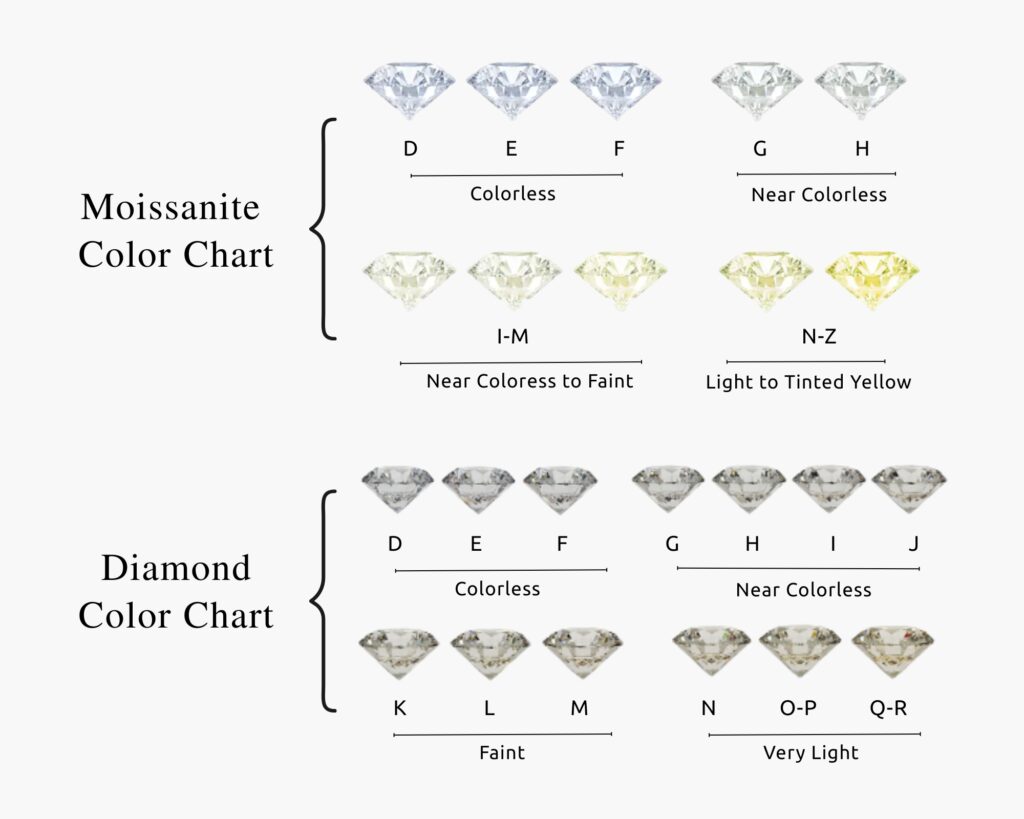
Price
| Size (in Carat/mm) | Moissanite Price | Diamond Price |
| 0.50ct/5mm | $500 | $1000 |
| 0.75ct/6mm | $700 | $2200 |
| 1ct/6.5mm | $850 | $4000 |
- Moissanite: Is moissanite good? Absolutely yes, moissanite costs around $250 to $1,000 per carat—only a fraction of the price of diamonds. It offers the option of larger, higher-quality stones at a lower price, making it a popular choice for budget-conscious buyers.
- Diamond: Natural diamonds are significantly more expensive, ranging from $1,000 to over $40,000 per carat depending on cut, color, clarity, and size. Diamonds are seen as traditional and tend to hold higher resale value.
Sourcing
- Diamond: Can be natural (mined) or lab-grown. Mined diamonds may raise ethical concerns; lab diamonds are more sustainable.
- Moissanite: Always lab-grown, making it an eco-friendly and conflict-free alternative by default.
Is a Moissanite a Real Diamond?
No, moissanite is not a real diamond—but it’s often mistaken for one due to its similar appearance. While both are clear, sparkling gemstones, they differ in composition, brilliance, and origin, etc. Diamonds are made of pure carbon, whereas moissanite is composed of silicon carbide.
Moissanite is considered a diamond simulant—a stone that imitates the look of a diamond but is chemically and structurally different. It offers a more affordable and ethically sourced alternative, but when compare moissanite vs diamond, it’s not the same as a diamond.
How to Tell a Diamond From Moissanite?
Can people tell the difference between moissanite and diamond? Even though they look the same at first glance, there are several ways through which you can tell a diamond from a moissanite if you come across them. Here are a number of things to look out for:
1. Light Dispersion or “Fire”
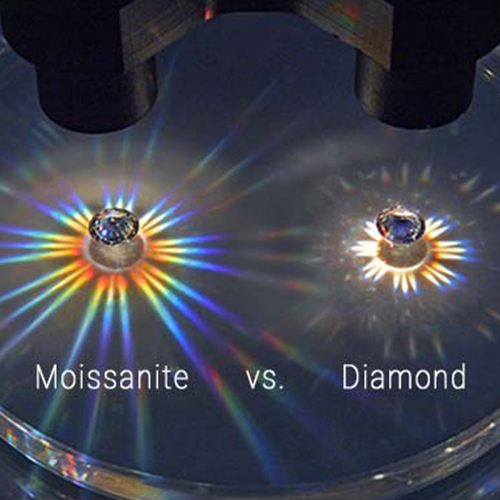
This is an easily visualized measurement of how light is dispersed into its constituent colors when it enters either gemstone. It is observable that light is better split into brighter, colorful components in moissanites than in diamonds. Thus, it can be said that moissanite has more fire than a diamond.
2. Price
If there ever was an answer to the question, “Why is moissanite better than diamond?” The answer lies in the pricing. Moissanites are way cheaper than diamonds while having similar aesthetics. A moissanite of the same size, shape, cut, and clarity as a diamond of the same proportions may hold just about 10 to 15% of the diamond’s worth. Therefore, if the price of a piece of jewelry that looks like a diamond sounds too good to be true, it most likely is a diamond look alike. However, a “diamond” piece of jewelry’s price by itself cannot guarantee its authenticity because you may purchase a fake for the same price as a real diamond.
3. Diamond Tester or Moissanite Tester
These are devices that can accurately determine the authenticity of a gem through the examination of its physical properties. However, a diamond tester will only tell you whether or not a gem labeled as a diamond is a diamond. The same goes for moissanite testers.
4. Moissanite Has More Clarity than Diamonds
Nowadays, the majority of moissanite sold is created in laboratories under closely regulated conditions that minimize internal flaws, which is why this stone typically has better clarity than most diamonds.
5. Brilliance
Because moissanites have a higher refractive index than diamonds. They are able to bend light better.
A polished spherical moissanite will appear to have doubled facets if you gaze through the top or side of the stone. You shouldn’t be able to see such an effect with diamonds. The light-bending ability of an object determines its brilliance, and in this regard, moissanites come out on top.
Conclusion
Due to their historical significance, distinctive qualities, rarity, great demand, and low supply, diamonds are valued higher than all other gemstones.
That said, there are a few substitutes for a diamond piece, and nothing does it quite like moissanites. Not only do they have more brilliance and fire than diamonds, but they are also clearer and almost as hard as diamonds.
If you’re deciding between diamonds and moissanite for your collection, contact a custom jewelry manufacturer to explore the best fit for your brand.
